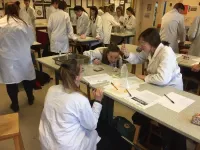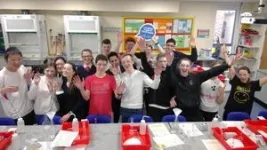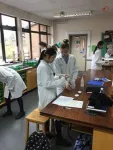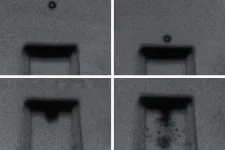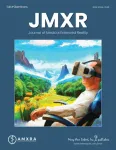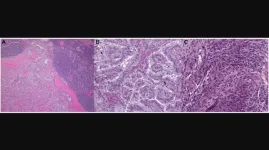(Press-News.org) Results of a large-scale innovative Citizen Science experiment called Project M which involved over 1000 scientists, 800 samples and 110 UK secondary schools in a huge experiment will be published in the prestigious RSC (Royal Society of Chemistry) journal CrystEngComm on 29 January 2024. The paper is titled: “Project M: Investigating the effect of additives on calcium carbonate crystallisation through a school citizen science program”. The paper shares a giant set of results from the school citizen scientists who collaborated with a team at Diamond to find out how different additives affect the different forms of calcium carbonate produced. These additives affect the type of calcium carbonate that forms, and thus its properties and potential applications. Being able to easily produce different forms of calcium carbonate could be very important for manufacturing.
Lead authors Claire Murray, Visiting Scientist at Diamond and Julia Parker, Diamond Principal Beamline Scientist and expert in calcium carbonate science who conceptualised the project, analysed the data, wrote and edited the manuscript explain that despite nature’s ability to precisely control calcium carbonate formation in shells and skeletons, laboratories around the world are often unable to exact the same level of control over how calcium carbonate forms. Nature uses molecules like amino acids and proteins to direct the formation of calcium carbonate, so we were interested in discovering how some of these molecules affect the calcium carbonate that we make in the lab.
Project M engaged the students and teachers as scientists, making different samples of calcium carbonate under varying conditions with different additives. 800 of these samples were then analysed in just 24 hours in April 2017 using the X-ray powder diffraction technique at on beamline I11 at Diamond Light Source, the UK’s national synchrotron. This created a giant set of results which form the basis of the publication. A systematic study of this scale has never been completed anywhere else in the world.
The goal of this project was to find out how using different additives like amino acids affect the structure of the calcium carbonate. The mineral has three main forms called ‘polymorphs’ – vaterite, calcite and aragonite – which can be identified using X-ray powder diffraction at Diamond’s beamline l11. Diamond Light Source produces one of the brightest X-ray beams on planet Earth, which allow scientists to understand the atomic structure of materials. Scientists come from all over the UK and further afield to use these X-rays – as well as infrared and ultraviolet light - to make better drugs, understand the natural world, and create futuristic materials. Understanding the impact of different additives on the production of polymorphs is of huge interest in industry such as in manufacturing, medical applications such as tissue engineering and the design of drug-delivery systems, and even cosmetics.
However, mapping such a large parameter space, in terms of additive and concentration, requires the synthesis of a large number of samples and the provision of high throughput analysis techniques. It presented an exciting opportunity to collaborate with 110 secondary schools making real samples to showcase the high-throughput capability of the beamline, including rapid robotic changing of samples, which means diffraction patterns can be collected and samples changed in less than 90 seconds.
“The project was led by a scientific question we had,” explained Claire Murray. “The idea to involve school students and teaching staff in the preparation of the samples followed naturally as we know Chemistry projects are underrepresented in the citizen science space. The contribution that student citizen scientists can make to research should not be underestimated. These projects can provide a powerful way for researchers to access volumes of data they might struggle to collect otherwise, as well as inspiring future generations of scientists.”
The project was designed with kit and resources to support the schools to learn new techniques and knowledge and to provide them with space to interact and engage with the experiment. After analysis at Diamond, the students had the opportunity to look at their results, see their peaks and determine what sort of polymorphs they had produced, and compare their results with the results obtained by different samples and different schools at different locations in the UK.
Gry E. Christensen, former student and Project M Scientist at Didcot Girls' School, Didcot commented; “It was an amazing journey and I recommend that if any other schools have a chance to help with a similar project, then jump on board, because it is a once in a lifetime opportunity for the students, and you feel you can make a positive change to the world.”
“The fact that we didn’t know the answer yet was a motivational factor for the students,” explains Claire Murray. “The teachers told us they took everything more seriously, because this was real science in action – it really meant something. They shared how the students were excited to translate their lab skills to this experiment and that the students were able to contextualise their learning from their prescribed textbooks and lab classes. Teachers also highlighted their own interest and curiosity as many of them have trained as chemists in their education. They appreciated the connection to real science for themselves and the opportunity for continued professional development.”
'The project offered our pupils a unique opportunity to take part in genuine scientific research and should act as a blueprint for future projects that aim to engage young people in science beyond the classroom.' Adds Matthew Wainwright, teacher and Project M Scientist at Kettlethorpe High School, Wakefield.
Exploring the role of amino acids in directing crystallisation with the Project M Scientists was an opportunity and an honour for the authors. Julia Parker explained; “In our work we see how we can draw novel scientific conclusions regarding the effect of amino acids on the structure of calcite and vaterite calcium carbonate polymorphs. This ability to explore a wide parameter space in sample conditions, whilst providing continued educational and scientific engagement benefits for the students and teachers involved, can we hope in future be applied to other materials synthesis investigations.”
Project M enabled schools to carry out real research and do an experiment that had never been done before, in their own school laboratory. It was the first ‘citizen science’ project run by Diamond, which transported Diamond science to schools and enabled the production of a considerable set of results, which has now resulted in this successful publication in CrystEngComm.
ENDS
For more information: please contact Diamond Communications: Lorna Campbell +44 7836 625999 or Isabelle Boscaro-Clarke +44 1235 778130 Diamond Light Source: www.diamond.ac.uk Twitter: @DiamondLightSou : Full-size imagery and video accompanying this press release can be provided.
Paper Title: DOI: 10.1039/d3ce01173a 29 January, 2024. CrystEngComm – “Project M: Investigating the effect of additives on calcium carbonate crystallisation through a school citizen science program.”
Authors: Claire A. Murray,*†a Project M Scientists, Laura Holland,b Rebecca O’Brien,c Alice Richards,a Annabelle R. Baker,a Mark Basham,b David Bond,a Leigh Connor,a Sarah J. Day,a Jacob Filik,a Stuart Fisher,d Peter Holloway,a Karl Levik,a Ronaldo Mercado,a Jonathan Potter,a Chiu C. Tang,a Stephen P. Thompsona and Julia E. Parker*† a
Further information: Due to its relevance and impact, the Royal Society of Chemistry presented its Inspiration & Industry Award for 2018 to Project M. The award recognises the originality and impact in chemistry education, among other areas. The award acknowledges the importance of teamwork across the chemical sciences, and teamwork was something that defined the success of Project M. All the aspects that needed to be considered – class length, transporting chemicals through the post, access to the results, the production of teaching materials and experiment protocols – implied a large array of the expertise that can be found at Diamond.
Claire Murray is a chemist who previously worked in the lab for powdered materials called Beamline I11. Claire was the co-project manager for Project M and coordinated the software, hardware and experiments necessary to make Project M happen. She is now a Visiting Scientist at Diamond, freelance science communicator and citizen science researcher. Julia Parker is the Principal Beamline Scientist and a chemist working in a Diamond lab called Beamline I14 where they use a nanometre sized X-ray beam to look at chemical and biological experiments. Her research expertise in calcium carbonate science was crucial to the success of the project and she co-project managed Project M.
Diamond Light Source provides industrial and academic user communities with access to state-of-the-art analytical tools to enable world-changing science. Shaped like a huge ring, it works like a giant microscope, accelerating electrons to near light speeds, to produce a light 10 billion times brighter than the Sun, which is then directed off into 33 laboratories known as ‘beamlines’. In addition to these, Diamond offers access to several integrated laboratories including the world-class Electron Bio-imaging Centre (eBIC) and the Electron Physical Science Imaging Centre (ePSIC).
Diamond serves as an agent of change, addressing 21st century challenges such as disease, clean energy, food security and more. Since operations started, more than 16,000 researchers from both academia and industry have used Diamond to conduct experiments, with the support of approximately 760 world-class staff. Almost 12,000 scientific articles have been published by our users and scientists.
Funded by the UK Government through the Science and Technology Facilities Council (STFC), and by the Wellcome Trust, Diamond is one of the most advanced scientific facilities in the world, and its pioneering capabilities are helping to keep the UK at the forefront of scientific research.
Diamond was set-up as an independent not for profit company through a joint venture, between the UKRI’s Science and Technology Facilities Council and one of the world’s largest biomedical charities, the Wellcome Trust - each respectively owning 86% and 14% of the shareholding.
END
Innovative school Citizen Science project involving over 1000 scientists, 110 schools, 800 samples and U.K.’s synchrotron published in CrystEngComm
A systematic study of this scale investigating the effect of additives on calcium carbonate crystallisation has never before been conducted at Diamond or anywhere else in the world - Easily producing different forms could be very important
2024-01-30
ELSE PRESS RELEASES FROM THIS DATE:
Probiotics promote weight loss in obese dogs
2024-01-29
Washington, D.C.—Researchers have identified 2 strains of probiotics that can be used to reduce weight in obese dogs. The research is published this week in Microbiology Spectrum, a journal of the American Society for Microbiology.
In the new study, the research team investigated metabolic diseases in companion animals and set out to identify probiotics suitable for long-term and safe treatment. “The initial challenge involved selecting specific metabolic diseases for examination, leading us to focus on the prevalent issue of 'obesity in pets,’” said study principal investigator Younghoon Kim, Ph.D., professor in the ...
Benchtop test quickly identifies extremely impact-resistant materials
2024-01-29
CAMBRIDGE, MA – An intricate, honeycomb-like structure of struts and beams could withstand a supersonic impact better than a solid slab of the same material. What’s more, the specific structure matters, with some being more resilient to impacts than others.
That’s what MIT engineers are finding in experiments with microscopic metamaterials — materials that are intentionally printed, assembled, or otherwise engineered with microscopic architectures that give the overall material exceptional properties.
In a study appearing today in the Proceedings of the National Academy of Sciences, the engineers report on a new way ...
Do tree-planting campaigns follow best practices for successful forest restoration?
2024-01-29
Global tree-planting campaigns have reached fad-like proportions over the past decade, and it’s easy to understand their appeal. Healthy forests help in the fight against climate change by absorbing some of our excess carbon dioxide emissions, and they can provide wildlife habitat and quality-of-life benefits for local human communities too. So why not plant more trees? It seems like an easy win.
But the problem is, there’s a huge difference between simply planting a tree and making sure that trees survive and grow over the long-term. And without the necessary ecological understanding or long-term planning and ...
Nearly two-thirds of low-risk pulmonary embolism patients are hospitalized after ED visit
2024-01-29
Embargoed for release until 5:00 p.m. ET on Monday 29 January 2024
Annals of Internal Medicine Tip Sheet
@Annalsofim
Below please find summaries of new articles that will be published in the next issue of Annals of Internal Medicine. The summaries are not intended to substitute for the full articles as a source of information. This information is under strict embargo and by taking it into possession, media representatives are committing to the terms of the embargo not only on their own behalf, but also on behalf of the organization they represent.
----------------------------
1. ...
Prenatal air pollution exposure linked to severe newborn respiratory distress
2024-01-29
HERSHEY, Pa. — Prenatal exposure to air pollution increases the risk of severe respiratory distress in newborn babies, according to new research conducted at the Penn State College of Medicine in collaboration with the Maternal-Infant Research on Environmental Chemicals (MIREC) Study led by Health Canada. The risk increases with exposure specifically to fine particulate matter (PM2.5) and nitrogen dioxide (NO2), which occur in wildfire and cigarette smoke and vehicle emissions, among other sources.
The findings, which published on Jan. 25 in the journal Environmental Health Perspectives, reveal a better understanding of ...
How a walk in nature restores attention
2024-01-29
New research from University of Utah psychology researchers is helping prove what American authors John Muir and Henry David Thoreau tried to teach more than 150 years ago: Time spent in nature is good for the heart and soul.
Amy McDonnell and David Strayer are showing it is good for your brain, too. Their latest research, conducted at the university’s Red Butte Garden, uses electroencephalography (EEG), which records electrical activity in the brain with small discs attached to the scalp, to measure participants’ attentional capacity.
“A walk in nature enhances certain executive control processes in the brain above and beyond the benefits associated with exercise,” ...
What is medical extended reality? New AMXRA guideline
2024-01-29
A new guideline to help define the emerging field of Medical Extended Reality. Which seeks to standardize terminology, categorize existing work, and provide a structured framework for future research development in MXR.
END ...
Emergency cardiovascular care impact goal outlines 3 target needs
2024-01-29
Statement Highlights:
Despite significant advances in research, education, clinical practice and community-based programs, survival from cardiac arrest remains low.
Significant disparities also exist in cardiac arrest outcomes.
This scientific statement specifically identifies impact goals to achieve or exceed by 2030 to improve cardiac arrest for all people.
DALLAS, January 22, 2024 — Only 10% of people who experience a cardiac arrest survive.[1] In new challenge goals outlined in the American Heart Association Emergency Cardiovascular Care 2030 Impact Goals and Call to Action to Improve Cardiac Arrest Outcomes, the American Heart Association’s volunteer ...
Genetic alterations in thyroid cancer mediate resistance to BRAF inhibition and anaplastic transformation
2024-01-29
“An improved understanding of the molecular basis of thyroid cancer has led to the development of new targeted agents.”
BUFFALO, NY- January 29, 2024 – A new research perspective was published in Oncotarget's Volume 15 on January 24, 2024, entitled, “Genetic alterations in thyroid cancer mediating both resistance to BRAF inhibition and anaplastic transformation.”
In this new paper, researchers Mark Lee and Luc GT Morris from New York Presbyterian Hospital and Memorial Sloan Kettering Cancer Center discuss thyroid cancer. A subset of thyroid cancers present at advanced stage or with dedifferentiated histology and have limited response to standard therapy. ...
Psychology research: Women more sensitive to cocaine
2024-01-29
Previous studies focused on cocaine use have found that women are more likely than men to develop an addiction, try cocaine at a younger age, use larger amounts of the drug, and suffer from overdose.
Now, a new study from researchers at The University of Texas at Arlington in the journal Pharmacology Biochemistry and Behavior finally validates what scientists have long suspected: The female sex hormone estradiol (a synthetic version of the naturally occurring estrogen) is responsible for why women are more susceptible to cocaine addiction than men.
“For the first time, we have shown that estradiol enhances the cocaine-conditioned reward,” said Linda Perrotti, ...
LAST 30 PRESS RELEASES:
The perfect plastic? Plant-based, fully saltwater degradable, zero microplastics
Bias in data may be blocking AI’s potential to combat antibiotic resistance
Article-level metrics would provide more recognition to most researchers than journal-level metrics
Satiety’s little helper: Protein that supports appetite regulating protein identified
UF dives deep into predicting storm damage with computer models
A stormy ocean voyage yields insights on the global carbon cycle
Scientists identify first non-coding gene that controls cell size
Demonstration of altermagnetism in RuO₂ thin films -- A new magnetic material for the AI era
Penn researchers awarded $25M to conduct trial using smartphones to fight heart disease
PCORI awards funding for new patient-centered healthcare research
Exploring the origins of the universe: 145 low-noise amplifiers complete ALMA telescopes
Empress cicada wings help illuminate molecular structure
Using sound waves to detect helium
Time burden in patients with metastatic breast and ovarian cancer from clinic and home demands
Researchers discover bias in AI models that analyze pathology samples
Scientists ID potential way to prevent brain injuries from triggering Alzheimer's
MASTER 2nd Open Call: Execution period kick-off
Algae for health in food and pharma
Advanced microrobots driven by acoustic and magnetic fields for biomedical applications
Chicago health information leader recognized for raising CPR readiness and blood pressure awareness
The Intimate Animal, a new book from Kinsey Institute Executive Director Dr. Justin Garcia
When blue-collar workers lose union protection, they try self-employment
New video dataset to advance AI for health care
MEA-based graph deviation network for early autism syndrome signatures in human forebrain organoids
New modeling approach sheds light on rare gut disease
Study documents potentially hazardous flame retardants in firefighter gear
Can certain bacteria regulate aging of the immune system and its related alterations?
AI model helps diagnose often undetected heart disease from simple EKG
There are fewer online trolls than people think
Cell membrane fluctuations produce electricity
[Press-News.org] Innovative school Citizen Science project involving over 1000 scientists, 110 schools, 800 samples and U.K.’s synchrotron published in CrystEngCommA systematic study of this scale investigating the effect of additives on calcium carbonate crystallisation has never before been conducted at Diamond or anywhere else in the world - Easily producing different forms could be very important
